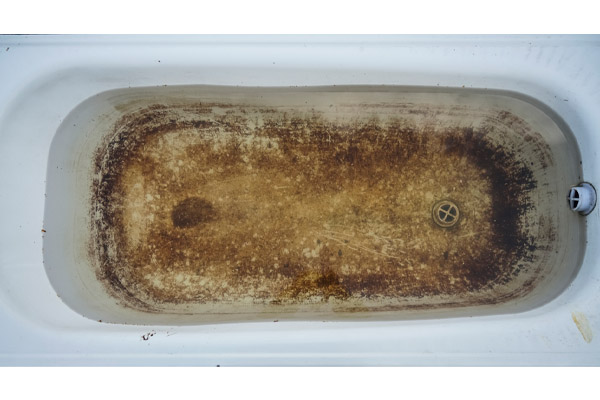Understanding the Phenomenon of Sewage Rising Through the Bathtub
Understanding the Phenomenon of Sewage Rising Through the Bathtub
Blog Article
The article down the page relating to Why is Sewage Backing Up Into My Bathtub? is quite remarkable. You should look it over.

Sewer back-up in the bathtub can be an upsetting and unhygienic problem for any kind of property owner. Not just is it inconvenient, yet it also presents significant health dangers and shows underlying concerns with the plumbing system. Understanding why sewage is turning up via the bath tub is crucial for taking suitable action to deal with the issue successfully.
Intro to the Problem
Typical Factors for Sewage Backup
Blockages in the Sewer Line
Among the most usual sources of sewage backup is a clog in the sewage system line. This can take place because of the accumulation of debris, oil, or international items in the pipes, preventing correct circulation and creating sewer to support right into your tub.
Tree Origin Invasion
Tree origins looking for dampness and nutrients can infiltrate sewer lines via tiny cracks or joints. In time, these origins can grow and broaden, creating considerable damage to the pipes and resulting in sewer backup problems.
Recognizing the Trouble
When sewer starts backing up into the bath tub, it's a clear indication of an issue with the drain system. The wastewater that ought to be flowing away from your home is rather locating its way back into your space, which can lead to considerable damage and carcinogen.
Possible Causes
Numerous variables can add to sewage backup in the tub. From obstructions in the drain line to problems with the plumbing framework, recognizing the source is necessary for discovering an option.
Aging Facilities
Older homes might have dated plumbing systems that are a lot more vulnerable to rust, cracks, and wear and tear. As pipelines age, they end up being a lot more prone to leakages and blockages, boosting the possibility of sewage backup incidents.
Heavy Rainfall or Flooding
Throughout durations of heavy rainfall or flooding, the sewer system might end up being overwhelmed with excess water, triggering back-ups and overflows. This can cause sewer supporting into bath tubs and other fixtures inside the home.
Signs of Sewer Backup
Foul Odors
Undesirable smells originating from drains pipes or components, particularly in the washroom, might suggest sewer backup issues. These odors are usually strong and relentless, signaling a problem that requires immediate attention.
Slow Draining Fixtures
Bathtubs, sinks, and commodes that drain pipes gradually or otherwise in any way could be experiencing sewer back-up. If multiple components are impacted simultaneously, it's most likely that the issue stems from a common factor, such as the primary sewer line.
Gurgling Noises
Unusual gurgling or bubbling noises originating from drains pipes when water is running somewhere else in your house are indicative of air caught in the plumbing system. This air accumulation can arise from sewer backup and must be checked out promptly.
Wellness Risks Associated with Sewage Back-up
Contamination of Supply Of Water
Sewage backup can pollute the water supply in your home, posing a major wellness threat to you and your household. Direct exposure to contaminated water can result in stomach issues, skin infections, and various other ailments.
Mold Growth
Moisture from sewage backup can create optimal problems for mold and mildew growth in your home. Mold spores can intensify breathing problems and cause allergies in delicate people, making prompt clean-up vital.
Spread of Disease
Sewer contains unsafe microorganisms, infections, and bloodsuckers that can cause a series of conditions, consisting of liver disease, cholera, and gastroenteritis. Entering contact with sewer or polluted surfaces places you in danger of infection.
Cleaning Up After Sewer Backup
Sanitation Procedures
Thoroughly decontaminate and sanitize impacted locations after sewage back-up to remove dangerous bacteria and stop mold and mildew growth. Use ideal cleansing items and protective equipment to ensure safe and efficient cleaning.
Restoration of Affected Areas
Repair any kind of damages to flooring, walls, or components brought on by sewer back-up. Relying on the level of the damages, you might require to change carpeting, drywall, or other materials to restore your home to its pre-loss problem.
Immediate Actions to Take
Switching Off Water
In case of sewage back-up, it's vital to turn off the water to prevent more contamination and damage. Find the primary water shutoff valve in your house and closed it off until the concern can be settled.
Getting In Touch With a Professional Plumber
Dealing with sewer back-up is not a do it yourself job. Contact a certified plumber with experience in handling sewage-related concerns to examine the scenario and perform needed repair work or clean-ups.
Avoiding Contact with Polluted Water
Until the sewage back-up is solved, avoid contact with infected water to prevent the spread of bacteria and virus. Wear safety equipment if you must be in the affected area and wash your hands thoroughly later.
Safety nets
Regular Upkeep of Drain Lines
Schedule routine inspections and upkeep of your sewer lines to recognize and attend to possible concerns before they intensify right into major problems. This can include cleaning out particles, checking for tree origin intrusion, and fixing any type of broken pipes.
Installing Bayou Valves
Take into consideration setting up bayou shutoffs in your plumbing system to avoid sewer from flowing back right into your home during periods of heavy rainfall or flooding. These shutoffs instantly close when water starts backing up, shielding your residential or commercial property from contamination.
Correct Disposal of Household Waste
Prevent purging anything other than toilet paper and human waste down the bathroom to prevent obstructions and clogs in the drain line. Dispose of grease, oil, and various other household chemicals effectively to minimize the threat of plumbing problems.
Why is there sewage coming up from my bathtub?
These gas fumes, like hydrogen sulfide – the gas that leaves a rotten egg smell in its wake and is highly flammable and toxic – can be hazardous to your health. Sewage poses major health risks as it contains harmful bacteria and microorganisms that can be dangerous if exposed to them.
Sewage cleanup should be considered an emergency.
So, why is there sewage coming up from your bathroom? There are several common causes of a sewage backup.
The most common reason for sewage coming up through your bathroom is a clogged sewer line. All plumbing in your bathroom connects to a single drain pipe that leads to the sewer line under your house. This drain line carries all wastewater and sewage away from your home to the city’s sewer system.
When the sewer line becomes clogged or blocked, wastewater has nowhere to go but back toward your house. This results in sewage coming up through your drains, often starting with your tub or shower.
Another culprit may be the sewage ejector pump, which is used when a bathroom, laundry room or any other type of plumbing fixture is located below the level of the main sewer or septic line flowing from the house. Most commonly, ejector pumps are used in homes with basement bathrooms or laundry rooms.
When you experience sewage coming up through your bathtub, it’s always best to contact a professional. Attempts to fix a clogged sewer line without experience often lead to more plumbing damage.
Make sure that no one enters the affected area, and open as many windows as possible. Pre-treat the flooded area with small splashes of chlorine bleach. Wear protection gear like rubber gloves, a mask, and water-resistant coveralls.
https://www.shawlocal.com/the-herald-news/sponsored/2022/08/17/omega-plumbing-10199038/

Hopefully you enjoyed reading our post on . Thanks so much for finding the time to read our piece. Sharing is good. Helping others is fun. Thanks a lot for taking the time to read it.
Schedule An Appointment
Report this page